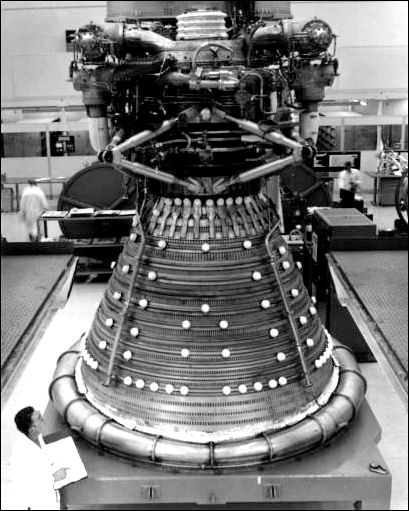
While Phillips and Shea worked on Apollo spending, schedules, mission assignments, and crew selection, Wernher von Braun and his Marshall Space Flight Center colleagues launched a series of three satellites that calmed many of the fears about micrometeoroid hazards of manned space flight in earth orbit. Astronomers had warned about the dangers of space dust to extended spacecraft flights, but Project Mercury had encountered no insuperable difficulties. With Gemini plans for manned spacecraft spending as much as two weeks in space, however, it was imperative that NASA have data from unmanned missions.
NASA's Office of Advanced Research and Technology and Marshall laid plans for a vehicle called "Pegasus" and hired the Fairchild Stratos Corporation to build it. By 1964, preliminary designs had been completed and ground testing begun. After considering various shapes, even some resembling parasols, Fairchild adopted a simple flat wing that would deploy in orbital flight to a span of 30 meters and expose 80 times more surface - a total of 700 square meters - than any previous detector in orbit.40
The last three Saturn I launches - numbered, in an odd sequence, 9, 8, and 10,* and called Saturn-Apollo (SA) or Apollo-Saturn (AS), depending on which documents (Marshall or Manned Spacecraft Center) were read - carried both Pegasus satellites and boilerplate (BP) Apollo spacecraft. SA-9 (or AS-103) was launched from the Cape on 16 February, tossing its two payloads into separate orbits. During its fourth revolution, the Pegasus registered its first micrometeoroid hit; two weeks later the count reached only a score; and by May the total was not more than 70. When the other Pegasus missions, launched on 23 May and 30 July, encountered as little orbital debris, Apollo engineers were more confident that micrometeoroids would cause few problems in earth orbit to the thin-skinned service module and much less to the command module wrapped in its protective heatshield cocoon.41
Pegasus provided near-earth data to Apollo; another unmanned vehicle, Ranger, gave a view of the ultimate goal - the moon. After many failures and in July 1964 one resounding success, Ranger ended with two sterling flights, one in February and one in March 1965 - much to the relief and credit of the Jet Propulsion Laboratory, the parent organization. Ranger VIII, aimed at the moon's equatorial zone in the Sea of Tranquillity, transmitted more than 7,000 pictures before it crashed. Engineers and scientists had an opportunity to study features no more than 30 centimeters in size. Ranger IX, heading for the crater Alphonsus, made the three-day trip with scarcely a course correction. Telemetry from this vehicle, translated and fed through commercial television, gave the public its first close-up view of the moon.42
Manned space flight was a beehive of activities in 1965, with the Gemini program recording five outstanding missions. The Soviet Union had twice flown its multimanned Voskhod spacecraft - in October 1964 and March 1965 - and the United States was eager to rejoin the competition. On 23 March after a 22-month hiatus in American manned flight, Virgil Grissom and John Young, in a three-orbit flight aboard Gemini III fired their spacecraft thrusters and changed their orbit. For the first time, man was truly controlling a spacecraft and its direction and speed in space. But this was only a spacecraft qualification flight. More ambitious missions were ahead for Gemini, to test the abilities of the astronauts in space and ground crews in the control center and around the worldwide tracking network in preparation for Apollo.
The next two Gemini missions, IV and V, were stepped increases in endurance, four days and eight days, each flight with its individual flavor. James McDivitt and Edward White flew a four-day mission 3-7 June that featured extravehicular activity and a practice rendezvous with the second stage of their launch vehicle. White, using a hand-held jet gun, propelled himself through space and floated at the end of a snakelike eight-meter tether with considerable aplomb.** The attempt to maneuver up to the spent booster stage was not so successful, however, causing some exponents of rendezvous to worry about the future. But little more than two months later, 21-29 August, Gordon Cooper and Charles Conrad embarked on an eight-day voyage and successfully carried out a "phantom rendezvous," catching an imaginary moving target set up by the flight controllers. Deputy Administrator Hugh Dryden wrote President Lyndon Johnson that the success of Gemini V, clearing the way for a two-week endurance test, "has assured us of man's capability to travel to the moon and return."43
Although Dryden did not live to see it (he died on 2 December), the year ended with the most exciting and ambitious space flight up to that time. Known to many as the "Spirit of '76," the concurrent flight of two manned Gemini spacecraft proved the feasibility of both long-duration flight and rendezvous. It began with the launch of Gemini VII, piloted by Frank Borman and James Lovell, on 4 December. Eleven days later, Walter Schirra and Thomas Stafford flew Gemini VI-A to a rendezvous with their orbiting compatriots to cap a banner year in space.44
Gemini's successes, although answering important questions, spawned some unwelcome suggestions for Apollo. White's spectacular extravehicular operation touched off plans for a similar exercise in the first manned Apollo flight; Shea vetoed that idea in a hurry. An even grander scheme pitted Gemini against Apollo. LEO, for "Large Earth Orbit" - all the way around the moon - was championed by Charles Mathews and André Meyer of the Gemini office and subsequently endorsed by Gilruth and Mueller. Since LEO could put Americans in the vicinity of the moon earlier than Apollo, it would be a big leap forward in the space race, which still loomed large in the minds of many people. Four Russian Luna missions had unsuccessfully attempted soft landings during 1965, demonstrating that the Soviet Union was still interested in the lunar target. Seamans vetoed LEO, believing Apollo needed no more competition. But Congress got wind of the plan and started asking questions. When Representative Olin E. Teague wanted to know if there would be any advantages to such a mission, Webb answered that it would be expensive and would still not guarantee success in beating the Russians to a lunar landing. Apollo was operating on a thin margin of resources as it was; if Congress wanted to spend more money, he told Teague, "I believe it would be in the national interest to [give it to] the Apollo program."45
So Gemini and Apollo were not to be rivals. Then could they perhaps assist each other? Howard W. Tindall, Jr. (whose specialty was mission planning and whose "Tindallgrams" achieved local fame), did not think so.*** They shared the mutual objectives of rendezvous, docking, and long-duration flight, but hardware and mission planning were so different and the respective managers were so busy trying to meet schedules that they could seldom afford the luxury of keeping abreast of each other's program.46
Apollo also had some operational successes in 1965 - none as spectacular as the Gemini flights but one at least more breathtaking than expected. Several dozen newsmen gathered at White Sands Missile Range, New Mexico, on 19 May to watch Mission A-003, an abort test of a boilerplate spacecraft at an altitude of 35,000 meters. At 6 that morning, the Little Joe II ignited and rammed its payload skyward. A few seconds after liftoff, a fin-vane at the base of the booster stuck and started the 13-meter-tall spacecraft-booster combination spinning like a bullet. Twenty-six seconds into the flight and still on a true course, the vehicle started coming apart. The abort-sensing system signaled the launch escape tower rocket to fire and pull the spacecraft away at an altitude of 4,000 meters. While newsmen watched the fluttering remains of the Little Joe II, BP-22's parachutes lowered it gently to the desert floor. Apollo had another answer: the launch escape system worked in a real abort situation.47
Little more than a month later, on 29 June, the launch team in New Mexico prepared to test an abort off the pad. The year before, a similar test had proved the escape tower rocket could jerk the spacecraft safely away from an exploding launch vehicle. But both the spacecraft and its escape system had since gained weight. In the second test, the rocket pulled the spacecraft higher in the air and farther downrange than expected.48

The F-1 engine at upper left, one of five fitted into the Saturn V's S-IC first stage, being prepared at the Rocketdyne plant in California for shipment to the Michoud launch vehicle assembly plant in Louisiana.
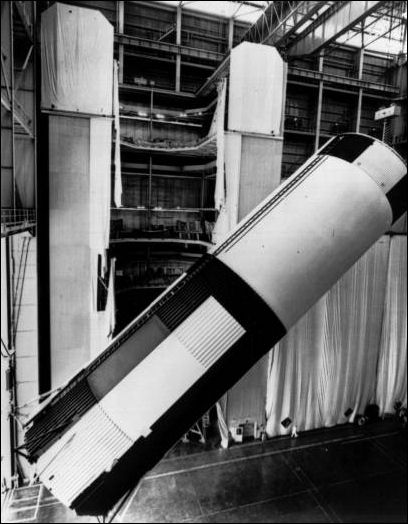
An S-IC stage at Michoud, 27 June 1965, is removed from its vertical assembly tower. After installation of wiring and components, this ground test version - the first in the Saturn V development program - would be shipped by barge to Marshall Flight Center in Alabama.
Perhaps one of the more heartening events during 1965 was the static-firing at the Mississippi Test Facility of the S-IC, the first stage of the Saturn V. The five F-1 engines, burning for six and a half seconds, produced the designed 33.4 million newtons (7.5 million pounds) of thrust, as much power as five Saturn Is lashed together. Going on up the Saturn V stack, the S-II second stage was static-fired in April and the S-IVB third stage in August, with excellent results.49 Although the Saturn I, with its ten straight launch successes, had already proved the clustered-stage concept, Mueller and his staff breathed easier after the Saturn V tests.
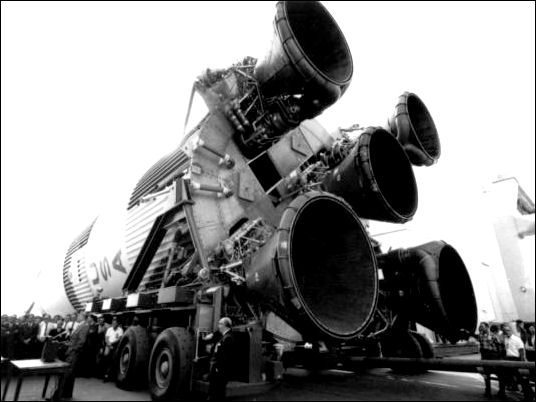
Marshall Director Wernher von Braun (at the microphone) held a brief ceremony 26 September 1965, accepting the first flight S-IC.
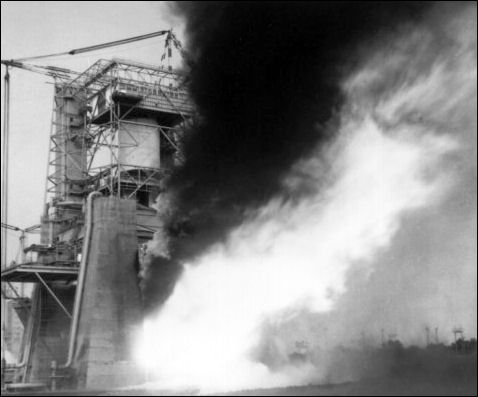
S-IC-T is fired for 2 1/2 minutes at Marshall in an August 1965 ground test.
Only solar radiation remained a worry of first rank at the end of 1965. During the year, a Solar Particle Alert Network was set up to study sunspots and to develop some techniques for predicting solar storms, so Apollo crews could take protective action against dangerous doses of radiation. The cyclical nature of sunspot behavior was, fortunately, fairly well understood. By using existing observatories and adding a few more (one at Houston), NASA intended to plan Apollo missions to avoid the periods of greatest solar activity.50
A new hazard discussed with increasing frequency during the year was the danger of back contamination from pathogenic organisms aboard a returning lunar spacecraft. The possibility of contaminating other planets during space exploration had long been recognized; now the risks of returning materials to the earth after exploratory voyages had to be faced. The United States Public Health Service was brought in to advise NASA on care of lunar samples and crews. Sharing the apprehensions, Congress hastily authorized the construction of a special quarantine facility in Houston. The Lunar Sample Receiving Laboratory, hurriedly built during the next two years, was one of the most elaborately safeguarded biological facilities in the world.51
Another indication that the operational phase of Apollo was approaching was Mueller's creation in July of a Site Selection Board to recommend lunar landing areas. Gilruth sent William Lee and William E. Stoney, Jr., to serve on this board, as well as on the Ad Hoc Surveyor Lunar Orbiter Utilization Committee (which Gilruth believed belonged in the same basket, anyway). The next month, John E. Dornbach's Lunar Surface Technology Branch compiled lists of candidate sites. In October, NASA announced that ten areas had been selected and that they would be photographed by Lunar Orbiter cameras during 1966.52
Picking sites and building a facility to handle samples and crews on their return to earth were good starts toward operations, but some communications and control systems problems remained to be ironed out. Early in its planning, NASA had seen the need for a "real-time computer complex" (RTCC) for instantaneous information on and control of manned space missions. Located at Goddard during all of Mercury and the early part of Gemini, the complex linked 17 ground stations around the globe and permitted observers to monitor manned flights on virtually a continuous basis. In addition, Mercury, Gemini, and Apollo needed digital applications in six other areas: premission planning and analysis; space flight simulations to aid manufacturers and astronauts; launch operations, so data could be instantly checked and analyzed; physiological monitoring of crewmen in flight, using biosensors; postflight mission analyses, so data on each flight could be catalogued and filed for future reference; and in the arena of worldwide testing, known to NASA by the fishy-sounding acronym CADFISS, for computer and data-flow integrated subsystems.
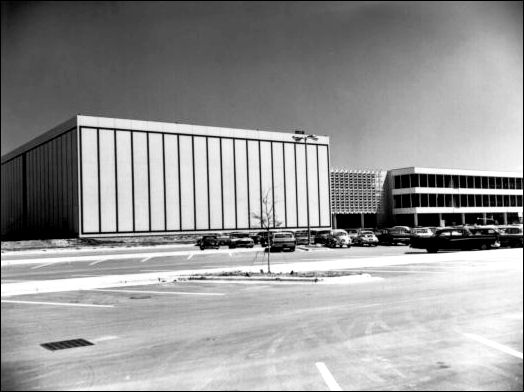
Mission Control Center, Houston.
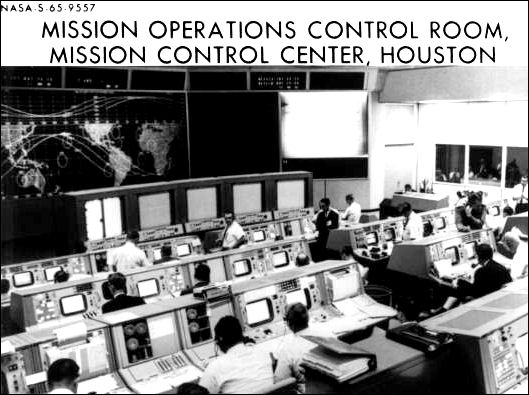
The mission operations control room during the Gemini V flight in August 1965. The room is in the windowless part of the building.
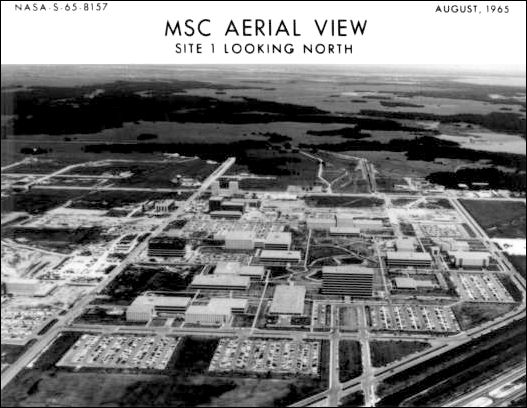
Manned Spacecraft Center during the mission. Mission Control is at the center, just to the right of the multistory building under construction.
After lengthy technical and administrative arguments, NASA moved the computer complex to Houston to form an "integrated mission control center." The center would have four main duties: processing global signals for display to flight controllers, computing and sending antenna-aiming directions to the global tracking stations, providing navigation information to the spacecraft, and simulating all mission data for personnel training and equipment checkout. By spring of 1965, Houston's computer complex was nearly ready, with five IBM 7094 model II computers on the line. Flight Director Chris Kraft assured Mueller the complex would be ready to control Gemini IV in June, and he was right. In September, a supplemental Univac 1230 was added to the complex, and plans were laid to replace the 7094s with new IBM 360 model 75s. Although the 7094s remained in service until 1968, modifications and upgrading provided a daily capacity of 80 billion calculations.53
Besides the enormous ground-based complexes, American industry had developed small computers for aeronautics and astronautics. While MIT's Instrumentation Laboratory was developing the Apollo guidance and navigation system, a major part of which was the onboard computer, throughout the computer industry there were breakthroughs in technology, based on microminiaturization, transistors, integrated circuits, thin-film memories, high-frequency power conversion, and multilayer interconnection boards.
Mercury had flown without onboard computers, but Gemini needed a digital computer and visual displays to control ascent, rendezvous, orbital navigation, and reentry. IBM delivered the first computer for a Gemini spacecraft in 1963, but NASA had been shopping around for a computer source for Apollo even earlier. In May 1962, NASA and MIT had selected Raytheon. Drawing on MIT's experience with Polaris missiles and nuclear submarines, Raytheon produced a general-purpose prototype by mid-1965.
The first Block I computer embodied significant advances over other computers. But it was soon discontinued because NASA decided to delete inflight maintenance and because the design was not satisfactory in either malfunction detection or packaging. The next, or Block II, version corrected these weaknesses. Weighing 31 kilograms and consuming only 70 watts of power during normal operation, the Block II "brains" incorporated redundant systems and had the largest memory of any onboard spacecraft computer to that time (37,000 words).54
* SA-9 was the last of the eight S-1 first stages built by Marshall; SA-8 was the first built by Chrysler at the Michoud facility in Louisiana. Chrysler needed more time to develop its stage, so SA-9 flew first.
** Soviet Cosmonaut Aleksey Leonov had taken the world's first space walk when he left the confines of Voskhod II on 18 March 1965.
*** Some Apollo engineers did not agree with Tindall. James C. Church thought Apollo might learn something about program control from Gemini, and Calvin H. Perrine wanted some expert advice on ground test programs from the office that had just gone through that experience. Duncan believed the Gemini sextant might be modified for use on Apollo. Rolf W. Lanzkron and Joseph P. Loftus, Jr., were anxious to learn anything they could from the crews that they might apply to Apollo. And H. B. Graham of North American, who made a comparison of Apollo and Gemini checkout procedures, assumed that further study might show some of the Gemini measures applicable to Apollo.
40. John Beltz, Roger Bilstein, and Mitchell Sharpe, "The Saturn Project: A Technological History of the Apollo Saturn Launch Vehicles," comment ed., 2 Jan. 1973, pp. 676-720; Lee B. James memos, "Project Name for MMC," 3 and 13 Aug. 1964; Perrine to Maynard, "Meteoroid protection for LEM and Block II," 28 Aug. 1964; Shea to NASA Hq., Attn.: Mueller, "Apollo spacecraft requirements for definition of the micrometeoroid hazard," 15 March 1965.
41. Leo L. Jones and A. Ruth Jarrell, "History of the George C. Marshall Space Flight Center, from January 1 through December 31, 1965," 1, April 1968, pp. 32-33; NASA, "Project: Pegasus-Saturn I," press kit, news release 65-38, 11 Feb. 1965; Edward R. Mathews TWX to NASA Hq. et al., "SA-9 Apollo Flash Report No. 1," 17 Feb. 1965; Mueller and Raymond L. Bisplinghoff to Admin., NASA, "Pegasus A/SA-9 Saturn I Flight Mission, Post Launch Report No. 1," 19 Feb. 1965, with enc.; NASA, "Pegasus I Relays Data on Meteoroid Hazards in Space," news release 65-68, 26 Feb. 1965; NASA, "Project: Pegasus II (SA-8)," press kit, news release 65-151, 6 May 1965; Mueller and Bisplinghoff to Admin., NASA, "Pegasus II/SA-8 Saturn I Flight Mission, Post Launch Report No. 1," 21 June 1965, with enc.; NASA, "Project: Pegasus C," press kit, news release 65-232, 14 July 1965; "Pegasus III Launch Caps NASA's Saturn I Program," NASA news release 65-253, 30 July 1965; Mueller and Bisplinghoff to Admin., NASA, "Pegasus III/SA-10 Saturn I Flight Mission Post Launch Report No. 1," 16 Aug. 1965, with enc.
42. R. Cargill Hall, Project Ranger: A Chronology, JPL/HR-2 (Washington, 1971), pp. 531-32; G. P. Callas to Maynard, Robert E. Vale, and John E. Dornbach, "Bellcomm report, 'Ranger VII Photo Analysis - Preliminary Measurements of Apollo Landing Hazards' C. J. Byrne," 22 April 1965, with enc., Bellcomm technical memorandum 65-1012-2, subj. as stated; NASA, "Project: Rangers C & D," press kit, news release 65-25, 4 Feb. 1965; NASA, "Ranger IX to Send World's First Live Moon Photos," news release 65-96, 23 March 1965.
43. A. A. Leonov, "The First Egress of Man into Space," paper presented at XVIth International Astronautics Congress, Athens, 13-18 Sept. 1965, NASA TT F-9727, October 1965; Barton C. Hacker and James M. Grimwood, On the Shoulders of Titans: A History of Project Gemini, NASA SP-4203 (Washington, 1977), chaps. X, XI; Hugh L. Dryden, "Significance of Gemini V Accomplishments," Cabinet report to the President, 11 Sept. 1965.
44. Hacker and Grimwood, On the Shoulders of Titans, chap. XII; Jerome C. Hunsaker and Robert C. Seamans, Jr., Hugh Latimer Dryden, 1891-1965, reprinted from Biographical Memoirs 40 (New York and London, 1969).
45. Ohlsson to Chief, SED, "Block I extra-vehicular activity," 15 April 1965; Lanzkron to Chief, SED, "EVA requirements for -012," 22 June 1965; Maynard to Lanzkron, "EVA in Block I," 29 July 1965; Olin E. Teague to James E. Webb, 18 Aug. 1965; Webb to Teague, 10 Sept. 1965.
46. Howard W. Tindall, Jr., to Chief, Mission Planning and Analysis Div., "Can Gemini contribute to Apollo?" 8 Jan. 1965; Church to Chief, PCD, "Program Control Operations Research," 25 Jan. 1965; Perrine to Chief, SED, "Gemini Ground Test Program Experience," 29 Nov. 1965; Duncan to Mgr., ASPO, "Air Force Gemini Space Sextant," 15 Feb. 1965; Lanzkron to Chief, Flight Crew Support Div., "Debriefing of GT-4 flight crew," 13 July 1965; Joseph P. Loftus, Jr., to Helmut A. Kuehnel, "Questions for GT-5 debriefing," 17 Aug. 1965; H. B. Graham, "Spacecraft Checkout: Apollo vs Gemini," 16 Feb. 1966.
47. MSC, "Postlaunch Report for Apollo Mission A-003 (BP-22)," MSC-A-R-65-2, 28 June 1965; Mueller to Admin., NASA, "Apollo Spacecraft Flight Abort Test, Mission A-003, Post Launch Report No. 1," 24 May 1965, with enc.; "Apollo Abort System Dramatically Tested," North American's Skywriter, 21 May 1965.
48. MSC, "Postlaunch Report for Apollo Mission PA-2 (BP-23A)," MSC-A-R-65-3, 29 July 1965; Mueller to Admin., NASA, "Apollo Spacecraft Pad Abort Test, Mission PA-2, Post Launch Report No. 1," 2 July 1965, with enc.
49. Astronautics and Aeronautics, 1965: Chronology on Science, Technology, and Policy, NASA SP-4006 (Washington, 1966), pp. 188, 198, 368, 373.
50. Maynard to Mgr., ASPO, "Apollo
Radiation Reliability Goals," 14 Jan. 1965; Gilruth to C. Gordon
Little, 27 July 1965; Little to Gilruth, 6 Aug. 1965; Adm. W. Fred Boone
memo for record, "Meeting to Discuss an Air Weather Service Plan
for a Solar Observing and Forecasting Network," 16 Aug. 1965; Henry
E. Clements to Asst. Dir., Flight Ops., "Status of Solar Particle
Alert Network (SPAN)," 17 Aug. 1965; Arthur Reetz, Jr., ed.,
Second Symposium on Protection against Radiations in Space,
NASA SP-71 (Washington, 1965), held in Gatlinburg, Tenn., 12-14 Oct.
1964; Reetz and Keran O'Brien, eds., NASA SP-169 (ANS-SD-5) (Washington, 1968).
51. M. Scott Carpenter, recorder,
minutes of MSC Senior Staff Meeting, 26 Feb. 1965, p. 2; Maynard to
Asst. Mgr., ASPO, "Lunar Surface Contamination," 14 Sept.
1965; Young TWX to Grumman, Attn.: Mullaney, 30 Nov. 1965; Johnston to
Mgr., Gemini Prog. Office, and Chief, Center Medical Off.,
"Biologic contamination of the lunar surface," 14 Dec. 1965;
William E. Stoney, Jr., to Chief, Eng. Div., "Support information
for FY 67 C of F Project - Lunar Sample Receiving Laboratory," 30
July 1965; Orr E. Reynolds memo for record, "Summary of meeting
between representatives of [NASA] and the Public Health Service, July
31, 1965," 17 Aug. 1965; James C. McClane, Jr., memo for record,
"Funding for development contracts necessary for Lunar Sample
Receiving Laboratory," 24 Sept. 1965, with enc.; Walter W.
Kemmerer, Jr., and Elbert A. King memo for record, "Summary of a
meeting between representatives of [NASA], Public Health Service and the
Department of Agriculture, MSC, Houston, Texas, September 17,
1965," 30 Sept. 1965; Lawrence B. Hall memo for Dir., Manned Space
Flight Prog. Control, "Quarantine Requirements - Lunar Landing
Program," 4 Nov. 1965; Low [Faget] draft letter to Lt. Gen. Frank
A. Bogart, 5 Nov. 1965; Webb to William H. Stewart, 20 Nov. 1965;
Slayton to E&D, Attn.: McClane, "Lunar Sample Receiving
Laboratory," 20 Nov. 1965; Col. Jack Bollerud to Dir., MSF Field
Center Development, "Public Health Service Proposed Congressional
Statement in Support of NASA Lunar Sample Receiving Laboratory," 14
Feb. 1966, with enc.; Bogart TWX to MSC, 1 July 1966; Senate Committee
on Appropriations' Subcommittee, Independent Offices
Appropriations for Fiscal Year 1967: Hearings on H.R. 14921, 89th
Cong., 2nd sess., 1966, pp. 839-40; McClane et al., "The Lunar
Receiving Laboratory," MSC brochure, 25 Oct. 1966.
52. NASA, "Apollo Site Selection
Board," Management Instruction (NMI) 1152.20, 6 Aug. 1965; Gilruth
to NASA Hq., Attn.: Mueller, "Establishment of Apollo Site
Selection Board," 29 July 1965; Newell to MSC, Attn.: Gilruth,
"Members of Ad Hoc Surveyor Orbiter Utilization Committee." 22
June 1965; Gilruth to NASA Hq., Attn.: Newell, subj. as above, 29 July
1965; Gilruth to Mueller, 5 Aug. 1965; NASA, "NASA Selects 10
Potential Photo Areas for Lunar Orbiter," news release 65-335, 20
Oct. 1965.
53. Allan E. Gamble, "Terrestrial,
Lunar, and Celestial Companions: The Support of Manned Spaceflight by
Computers" (term paper, University of Houston, 1 May 1972); MSC,
"Statement of Work for Real Time Computer Complex," May 1963;
NASA, "Mission Control Center at Houston to Handle GT-4, Subsequent
Manned Flights," news release 65-119, 9 April 1965; Earl D. Hilburn
for Assoc. Admin. for Manned Space Flights, "Computing Equipment
Requirements," 14 July 1965; Everett E. Christensen to James C.
Elms, "Effect of Further Delay in RTCC Computer Decision," 27
Sept. 1965; Seamans to Assoc. Admin., OMSF, "RTCC Computer
Requirements for Project Apollo," 7 Oct. 1965; Mueller to Gilruth,
21 Oct. 1965, with enc.. Seamans to Assoc. Admin., OMSF,
"Procurement Plan for Revision of Real-Time Computer Complex,
MSC," 19 Oct. 1965.
54. Gamble, "Terrestrial, Lunar,
and Celestial Companions," pp. 9-15; Shea to NASA Hq., Attn.:
Phillips, "Summary report of the Apollo guidance computer failure
history," 21 June 1965, with enc.; North American Space Div.,
Public Relations Dept., Apollo Spacecraft News Reference,
rev. ed. (Downey, Calif., 1969), p. 244.


